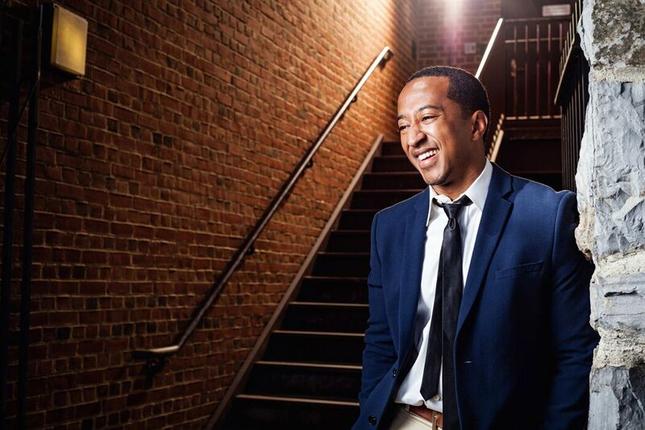Meadows to Step Out as Jelly Roll Morton at Signature
By • July 27, 2016 0 1411

You may have seen pictures of Mark G. Meadows, usually smiling, playing the piano in jacket and tie. He looks like a class act. But walking into Tryst, the popular Adams Morgan coffeehouse on 18th Street, he looks like a cool young guy from the neighborhood.
We talk a little before he heads out to a rehearsal for the lead role of legendary jazz and blues man Jelly Roll Morton in “Jelly’s Last Jam,” which opens at Signature Theatre Aug. 2.
Even for the multi-talented, multi-faceted, world-traveling Meadows, taking on the lead role of Morton is a big deal, a challenge, a leap of faith.
“I had to think about this,” he said. “I sing, I play, I compose, sure, but this is about acting, being an actor, which — truth be told, I’m a performer, and a musician, yes, but this is different. And the role, it’s critical. This is about Jelly Roll Morton. So when I was offered this — I was at Dizzy’s in New York at the time — I thought, wow. Acting. On stage. I mean, when I perform, we do call and respond, you know, but still. But when Matthew Gardiner, the director at Signature, came to me and said I should be doing this, well, you know, it gives you confidence. I trust Matthew and if he thinks I can do this, well, you have to do it.”
Speaking of the show, Gardiner, who recently directed the hugely successful production of “West Side Story” at Signature, said: “It’s a musical I’ve loved for years and it has one of the most beautifully rendered and complex roles ever written for the musical theater in Jelly Roll Morton.
“When I encountered Mark G. Meadows, I knew I found our Jelly,” he said. “I am so excited to reimagine this piece with a phenomenal jazz artist, alongside people like Felicia Boswell and Cleavant [Derricks] and a brilliant company of actors.”
“Jelly’s Last Jam” kicks off the new season for Signature in its Max Theatre, which is being turned into the Jungle Inn night club, an appropriate image for the life and times of Morton, a jazz pioneer with a huge gift and an outsized personality.
“He was a pioneer, so much so that he insisted that he invented the form,” Meadows said. “But he helped popularize jazz and the blues, he was a businessman, he led the way to big band music, he was an innovator, a band leader and singer. He was a very complex man.”
Born in New Orleans in 1890, Morton, who in his youth played in a brothel (or fancy house, as it was dubbed back then), was already a big star when he came to Washington in 1936 to take up residence in a club called at various points the Music Box, the Blue Moon Inn and the Jungle Inn.
“So yeah, there’s that local thing,” Meadows said. “There’s a big connection here.”
Meadows is kind of deceptive; he’s intense, but also laid back, deeply knowledgeable about jazz and expansive about its future, about the need to make a kind of big tent of the music. He’s young, but he’s also piled up a career and a life that’s thick with accomplishment.
“One way or another, I’ve always been around music,” he said. He was living in Washington when he was 3 years old and his father, Gabe Meadows, himself a jazz vocalist who’s big in clubs in Dallas these days, brought home a Casio keyboard and said, the story goes, “Have at it.”
Meadows did, but in eclectic, unexpected ways, especially early on. When the family moved to Dallas, he first studied classical piano under Rozalie Levant, a Russian-born classical pianist, and then, some years later, with Julie Bonk, a revered Dallas jazz pianist who also taught Norah Jones.
Meadows went to Johns Hopkins University, where he got a degree in psychology along with a degree in jazz piano from the Peabody Conservatory.
Though by now he’s performed all over the world, from Argentina to Europe to Qutar, his biggest influence is “my dad,” Meadows said. “Through listening to him, I also got to hear other great musicians: Ahmad Jamal, Oscar Peterson, Herbie Hancock, Al Jarreau.”
Meadows teaches — as an adjunct instructor at the Duke Ellington School of the Arts — and in 2014 was named “Artist of the Year” and “Composer of the Year” by the City Paper.
Listening to him talk, you get a sense of the music. It’s rich in different kind of songs and compositions; it includes hip hop and rap and a kind of focused improvisation. If you want to get a true sense of Meadows, check out his latest album “To the People,” which he’s done as Mark G. Meadows and the Movement, describing it as “an alliance of combined action through music.”
Musically, it’s a powerful album. It reels you in with its different tones and rhythms, its cool insistence on Meadows’s own compositions like “Live to Look Back” and “To the People” and its embracing and bracing version of Marvin Gaye’s “What’s Going On.” “Look what’s going on today, that division among races and people. I think we can do something about it through music, through what we do,” he said.
He’s been busy — performing at Blues Alley, Bohemian Caverns (which closed this spring), Strathmore, the Kennedy Center’s Millennium Stage, Bethesda Blues & Jazz. He also directs “The Mellow Tones,” a jazz vocal ensemble group (which can be heard on “To the People”) and with which he opened for Kendrick Lamar’s performance with the National Symphony at the Kennedy Center.
But now, here comes Mark G. Meadows. Here comes Jelly Roll Morton.

